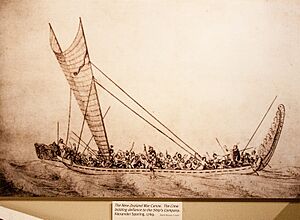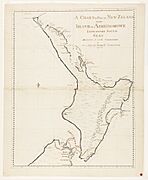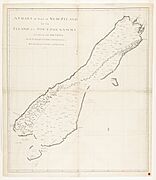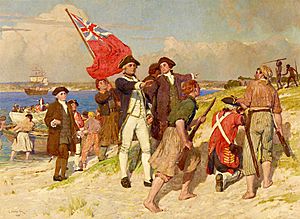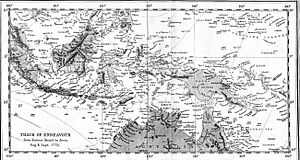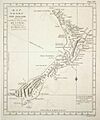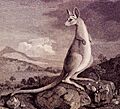First voyage of James Cook facts for kids
The first voyage of James Cook was a big adventure by the Royal Navy and the Royal Society. They sailed the ship HMS Endeavour across the south Pacific Ocean from 1768 to 1771. This was the first of three amazing trips that James Cook led.
The main goals of this journey were to watch the planet Venus pass in front of the Sun in 1769. This helped scientists measure how far Earth is from the Sun. They also wanted to find out if there was a huge, unknown southern land called Terra Australis Incognita.
King George III ordered this voyage. Lieutenant Cook, a skilled mapmaker and mathematician, was chosen to lead it. The expedition left Plymouth Dockyard in August 1768. They sailed across the Atlantic Ocean, around Cape Horn, and reached Tahiti just in time to see Venus cross the Sun.
After that, Cook explored the mostly unknown ocean to the south. He stopped at islands like Huahine, Borabora, and Raiatea. He claimed these islands for Great Britain. In October 1769, the team reached New Zealand. They were only the second Europeans to visit, after Abel Tasman 127 years earlier. Cook and his crew spent six months mapping the New Zealand coast.
Then, they sailed west across the open sea. In April 1770, they became the first known Europeans to reach the east coast of Australia. They landed near what is now Point Hicks and then went north to Botany Bay.
The expedition continued along the Australian coast. They almost crashed on the Great Barrier Reef. In October 1770, the damaged Endeavour arrived at Batavia (now Jakarta) in the Dutch East Indies. The crew had to keep their discoveries a secret. They left Batavia on December 26, rounded the Cape of Good Hope on March 13, 1771, and arrived back in Deal, England, on July 12. The whole trip lasted almost three years!
The year after he returned, Cook started his second voyage to the Pacific (1772–1775). His third and final voyage was from 1776 to 1779.
Contents
Why the Voyage Happened
In 1768, a group of scientists called the Royal Society asked King George III for money. They wanted to send a science trip to the Pacific. Their goal was to watch Venus pass in front of the Sun. This would help them figure out the distance from Earth to the Sun.
The King agreed to the trip. The British Admiralty (the navy leaders) decided to add a secret mission. They wanted Cook to search the south Pacific for a huge, unknown continent. This land was called Terra Australis Incognita, or the "unknown southern land."
Some newspapers wrote about the trip's goals. They mentioned observing Venus and making new discoveries in the "vast unknown tract" of the southern ocean.
A geographer named Alexander Dalrymple wanted to lead the trip. He believed the Southern Continent had millions of people. He thought trading with them would make Britain very rich. But he wanted to be a captain in the Royal Navy, even though he wasn't a sailor. The head of the Admiralty, Edward Hawke, refused. He said he would never let someone who wasn't a trained sailor command a Navy ship.
This problem was solved when the Admiralty suggested James Cook. He was a naval officer who was good at math and making maps. Both sides agreed, and Cook was promoted to Lieutenant. He became the commander of the expedition.
Getting Ready for the Trip
The Ship and Supplies
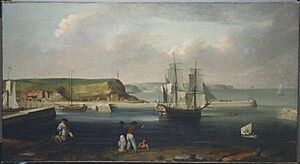
The ship chosen for the voyage was a merchant ship called Earl of Pembroke. It was built in 1764 in Whitby, England. It was a strong ship with a flat bottom. This design was good for sailing in shallow water. It also meant the ship could be pulled onto a beach for repairs.
The Admiralty bought the ship in May 1768. It was then prepared for the long journey. They added a third deck inside for cabins and storage. The ship was also given ten cannons and twelve smaller guns for protection.
They loaded a lot of food for the trip. This included 6,000 pieces of pork, 4,000 pieces of beef, and nine tons of bread. They also had sauerkraut, raisins, cheese, and other foods. For drinks, they had beer, brandy, and rum.
Secret Orders
Cook received two sets of secret instructions from the Admiralty. The first part was about sailing to Tahiti. The second part was about what to do after observing Venus.
After Tahiti, Cook was told to sail south. He had to look for the 'Southern Continent'. Then, he was to turn west towards New Zealand. From there, he could choose his way home. The orders did not mention New Holland (which is what Australia was called back then).
The Crew
The ship's company had 73 sailors and 12 Royal Marines. Lieutenant James Cook, who was 40, was in charge. His second-in-command was Zachary Hicks. The third lieutenant was John Gore, who had sailed around the world before.
Other important people joined the trip. Charles Green was the official astronomer. Joseph Banks was the official botanist. Banks paid for seven other people to come with him. These included two naturalists, two artists, a secretary, and two servants.
The Journey Begins
From England to Tahiti
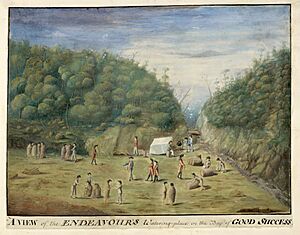
Cook left Plymouth on August 26, 1768. There were 94 people on board and enough food for 18 months. On November 15, the Endeavour reached Rio de Janeiro in Brazil. They stayed there to get more supplies and make repairs.
The local leader, the Marques de Azambuja, was suspicious. He thought Britain wanted to expand its power. Cook told him the trip was for science, but the Viceroy didn't fully believe him. Cook was annoyed by this.
The ship then sailed around Cape Horn. They continued west across the Pacific. On April 13, 1769, they arrived at Matavai Bay in Tahiti. This was where they would watch Venus. The event was set for June 3. Cook built a small fort and observatory at a place now called Point Venus.
Watching Venus
Charles Green was the astronomer for this task. The main goal was to measure the distance of Venus from the Sun more accurately. If they could do this, they could then figure out the distances of other planets. This would also help them find the exact longitude (east-west position) anywhere on Earth.
On the day of the event, Cook wrote about it. But the measurements taken by Green, Cook, and Solander were different. Their tools were good for the time, but they couldn't get rid of all the errors. When their results were compared with others around the world, they weren't as precise as hoped. Scientists now think this was due to optical effects, like the "black drop effect," which made it hard to see clearly.
Exploring the Society Islands
After watching Venus, Cook opened his secret orders. He was told to search the south Pacific for the unknown continent of Terra Australis. The Royal Society really believed this continent existed. They wanted Britain to find and claim it first.
But Cook decided to explore the nearby islands first. A local priest and sailor named Tupaia joined them. He was very helpful as a guide, interpreter, and peacemaker.
The Endeavour left Tahiti on July 13. On July 16, they entered the harbor of Huahine. Cook gave the chief a special plate to show they had discovered the island. From Huahine, Cook sailed to Raiatea. On July 20, he raised the flag and claimed Raiatea-Tahaa and nearby islands for Great Britain. He named them the Society Islands.
On August 9, Cook sailed south as instructed. After sailing about 2,400 kilometers, the Endeavour reached 40 degrees south latitude. But they didn't see any continent. So, Cook turned west towards New Zealand.
Discovering New Zealand
First Meetings with Māori People
Cook arrived in New Zealand on October 6, 1769. His group was only the second known Europeans to visit, after Abel Tasman in 1642. Cook and a landing party went ashore on October 7 at Poverty Bay on the North Island.
In their first two days, some meetings with the Māori ended sadly. Four or five local people were killed. Three more Māori died in another meeting farther south. Cook wrote in his journal that he regretted these events. He had been told to avoid fighting with local people.
Later meetings at Anaura Bay and Tolaga Bay were more peaceful. Tupaia, who understood the Māori language, helped a lot. He was an interpreter and helped the two groups get along. The Māori traded with the Europeans. They also let them collect water and plants.
Mercury Bay
Sailing north, the Endeavour next stopped at Mercury Bay. Here, Cook watched the planet Mercury pass in front of the Sun on November 9. Relations with the Māori were mostly peaceful. One local person was killed in a trading argument. This was the last recorded death of a Māori by Cook’s crew. After claiming Mercury Bay for Great Britain, Cook sailed out of the bay on November 15.
Sailing Around the North Island
Cook continued north, stopping at Bream Head and the Bay of Islands. He then sailed around North Cape in strong winds. He just missed meeting a French expedition led by Jean-François-Marie de Surville.
By mid-January 1770, Cook reached Queen Charlotte Sound on the South Island. He liked this spot and would use it on his later voyages.
On January 22, Cook explored Arapaoa Island. He climbed Kaitapeha Peak and saw the strait that separated New Zealand's North and South Islands. He named it Cook Strait. This proved that the North Island was not part of the supposed southern continent.
On January 31, Cook claimed Queen Charlotte Sound and the nearby lands for King George III. This was the last time he would claim New Zealand land for Britain. The Endeavour left the sound on February 5. Passing through Cook Strait, Cook mapped the coast from Cape Palliser to Cape Turnagain. This finished his trip around the North Island.
Sailing Around the South Island
Cook then sailed down the east coast of the South Island, mapping it and still looking for the southern continent. The Endeavour rounded South Cape on March 10. This showed that the South Island was not the huge sixth continent everyone was looking for.
Cook continued north along the west coast of the South Island without landing. He then re-entered Cook Strait and turned into Admiralty Bay on March 27. He had now sailed all the way around southern New Zealand.
Cook wrote in his journal on March 31, 1770, that his voyage had disproved most ideas about a Southern Continent north of 40 degrees South. He said he didn't know what might be south of that line.
- Cook's maps of the North and South Islands
Exploring the Australian Coast
Cook then sailed west. He wanted to find Van Diemen's Land (now Tasmania) to see if it was part of the southern continent. But strong winds pushed them north. On April 19, 1770, at 6 a.m., they saw land. Cook named it Point Hicks, after the officer who saw it first. This was on the south-eastern coast of Australia. Cook's team was the first known Europeans to see its eastern coastline.
Cook wrote in his journal about seeing the land. He thought Van Diemen's Land should be due south. But since the coast went southwest, he doubted it was connected.
Today, Point Hicks is between the towns of Orbost and Mallacoota in Victoria. The name was changed back to Point Hicks on the 200th anniversary of the sighting.
Botany Bay and First Meetings with Aboriginal People
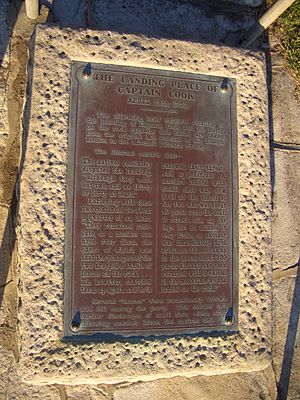
The Endeavour kept sailing north along the coast. Cook mapped and named places as he went. About a week later, they found a wide, shallow inlet. They anchored near a low sandy headland.
On April 29, Cook and his crew landed on the continent for the first time. This was at a beach now called Silver Beach in Botany Bay (Kamay). Two Gweagal men from the Dharawal / Eora nation came to the boat. They thought the Europeans were spirits of the dead. They shouted 'warra warra wai', meaning 'you are all dead', and pointed with their spears.
Cook's group tried to show they wanted water. They threw gifts like beads and nails ashore. But the two Aboriginal men kept trying to stop them from landing. Cook fired a warning shot. One Gweagal man threw a rock, and Cook fired small shot, wounding him in the leg. The crew then landed. The Gweagal men threw two more spears before Cook fired again, and they left. The landing party found children in nearby huts and left gifts for them. They also collected spears and other items.
Cook and his crew stayed at Botany Bay for a week. They gathered water, wood, and plants. They also explored the area. The local people watched the Europeans closely. But they usually moved away when the Europeans came near. Cook's group tried to make friends, but the Aboriginal people didn't want their food or gifts. Sometimes, they threw spears as a warning.
At first, Cook named the inlet "Sting-Ray Harbour" because of all the stingrays. Later, it was changed to "Botanist Bay" and then Botany Bay. This was because of the unique plants found by the botanists Joseph Banks and Daniel Solander. This first landing spot was later suggested as a good place for a British settlement.
Port Jackson
On May 6, 1770, the Endeavour left Botany Bay. They sailed north past an inlet that looked like a safe place to anchor. Cook named it Port Jackson, which is now known as Sydney Harbour. No one on the ship saw the many islands inside the harbor. Tall cliffs blocked their view.
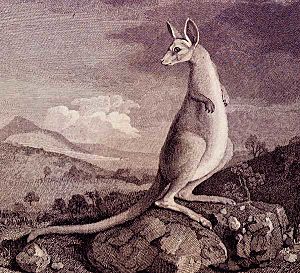
Seventeen Seventy
Cook continued north, mapping the coastline. On May 23, 1770, he stopped at Bustard Bay, now called Seventeen Seventy. Cook and Banks went ashore. They found a freshwater stream and noted that a few ships could anchor safely there. Cook saw a lot of smoke on the hills. He looked at a group of ten fires with shells around them, showing Aboriginal people had been there.
Endeavour River
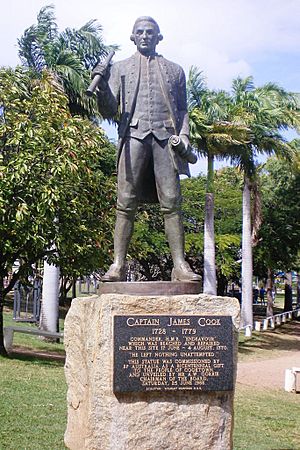
On June 11, 1770, a problem happened. The Endeavour hit a sandbank on the Great Barrier Reef. The ship was badly damaged. The voyage was delayed for almost seven weeks while they repaired the ship on a beach. This was near where Cooktown is today, at the mouth of the Endeavour River.
While there, Joseph Banks, Herman Spöring, and Daniel Solander collected many Australian plants. The crew's meetings with the local Guugu Yimidhirr people were mostly peaceful. But after a disagreement about green turtles, Cook ordered shots to be fired, and one local was slightly hurt. The word "kangaroo" came into the English language from the Guugu Yimidhirr word gangurru.
Possession Island
Once the repairs were done, the voyage continued. Around midday on August 22, 1770, Cook reached the northernmost point of the coast. He named it York Cape (now Cape York). He then left the east coast. Turning west, he carefully sailed the damaged ship through the shallow waters of Torres Strait. Luis Váez de Torres had sailed here in 1606.
Cook looked for a high spot to see if there was a passage to the Indian Ocean. He saw a steep hill on a nearby island. Cook named this island Possession Island. From here, he claimed the entire eastern coastline he had explored as British territory.
By sailing through the Torres Strait, Cook also proved that New Holland (Australia) and New Guinea were not connected.
Preventing Scurvy
At this point in the voyage, Cook had not lost a single man to scurvy. This was amazing for long sea trips in the 1700s. Cook followed a Royal Navy rule from 1747. He convinced his men to eat foods like citrus fruits and sauerkraut. Back then, they knew a bad diet caused scurvy, but not that it was a lack of vitamin C.
Sailors often didn't like new foods. At first, the men wouldn't eat the sauerkraut. Cook used a clever trick. He ordered it for himself and the officers. He then offered it to any crew members who wanted some. Within a week, seeing their leaders eat it, the demand was so high that they had to ration it. Sometimes, Cook had to use naval rules. He punished two men with lashes for refusing to eat their fresh beef.
Cook's main idea was to encourage a wide variety of foods. He collected green plants whenever they landed. Everyone on board ate the same food. Cook made sure everything was divided equally.
Two cases of scurvy did happen, to astronomer Charles Green and the Tahitian navigator Tupaia. But Cook was proud to write that when they reached Batavia, he had "not one man upon the sick list." Many other voyages arrived there with sick crews.
The Journey Home
The Endeavour then visited the island of Savu for three days. After that, they went to Batavia, the main city of the Dutch East Indies, for repairs. Batavia was known for malaria outbreaks. Before they got home in 1771, many of Cook's crew got sick with malaria and other illnesses like dysentery. This included Tupaia, Banks' assistant Herman Spöring, astronomer Charles Green, and artist Sydney Parkinson. Cook named Spöring Island off New Zealand to honor Herman Spöring.
Cook then sailed around the Cape of Good Hope and stopped at Saint Helena. On July 10, 1771, Nicholas Young, the boy who first saw New Zealand, saw England again. The Endeavour sailed up the English Channel. On July 12, the ship anchored in the Downs, and Cook went ashore at Deal, Kent. His return was a surprise. Newspapers had reported fears that the Endeavour was lost at sea.
Remembering the Voyage
In 1959, the Cooktown Re-enactment Association started performing a play about Cook's 1770 landing in Cooktown, Australia. They still do it every year. Many local Guugu Yimithirr people help. They celebrate the first act of reconciliation between Indigenous Australians and non-Indigenous people. This happened after a disagreement over green turtles. Cook and his crew had been friendly with the locals and learned some of their language. But when the crew wouldn't share 12 turtles, which broke local customs, the locals got angry. An elder stepped in and gave Cook a broken spear as a peace offering. This stopped a fight.
In 1970, Hans Hass made a TV documentary called Unsere Reise mit James Cook (Our Journey with James Cook). He followed Cook's journey through the Great Barrier Reef using Cook's journal. Hass even dived in different places.
In 2001, the BBC made a documentary series called The Ship: Retracing Cook's Endeavour Voyage. A film crew, volunteers, and historians followed part of Cook's trip from Cairns to Jakarta. One of the historians, Alexander Cook, wrote about the journey in his 2004 article "Sailing on The Ship: Re-enactment and the Quest for Popular History."
Images for kids
-
Earl of Pembroke, later HMS Endeavour, leaving Whitby Harbour in 1768. By Thomas Luny, dated 1790
-
A view of the Endeavour's watering place in the Bay of Good Success, Tierra del Fuego, with natives. Alexander Buchan, January 1769.
-
Captain Cook landing place plaque
-
This kangaroo was seen at Endeavour River on 23 June 1770, painted by Sydney Parkinson
-
Captain James Cook Commander, H.M.B. "Endeavour" which was beached and repaired near this site 17 June – 4 August 1770
-
Route of Endeavour from the Torres Strait to Java, August and September 1770




